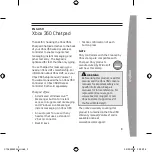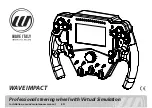
10
BAS-SVX62E-EN
Overview
Controller Comparisons
shows the comparison of the UC210/UC400 controllers to the VV550/551 and the VAV 4.2.
Static Pressure Optimization: As a part of the standard application, VAS calculates the duct static pressure setpoint based on the VAV unit with a damper in the
maximum flow position.
Ventilation Optimization:
As a part of the standard application, the VAV system has the ability to calculate the ventilation setpoint for the air handler unit. In
addition, the UC210 controllers have a ventilation ratio limit feature that automatically increases airflow to maintain the required
ventilation while operating within system limits for outside air percent concentrations in the supply air stream.
CO
2
-based Demand Control
Ventilation:
As a part of the standard application, the VAV system has the ability to calculate the ventilation setpoint for the air handler unit based
on the CO
2
concentration in one or more spaces.
Ventilation Flexibility:
Ventilation can be managed in the following ways:
• Fixed occupancy ventilation setpoint
• Scheduled (calculated) ventilation setpoint
• Occupancy sensor to switch between normal and reduced ventilation
• CO
2
sensor for demand-controlled ventilation
Temperature Statistics: As a part of the standard application, both the VAS and Area applications calculate the minimum space temperature (and source),
maximum space temperature (and source), and the average space temperature.
UC210 Controller Compatibility: The UC210 controller integrates with other BACnet systems and devices using BACnet MS/TP. The UC210 controller provides standard
BACnet objects (data points) that can be read by and/or written to by other systems.
Table 2.
UC210 Features (continued)
Feature
Description
Table 3.
Comparison of UC210/UC400 to VV550/551 and VAV4.2
Tracer UC210/UC400
Tracer VV550/VV551
VAV 4.2
Supports BACnet.
Supports LonTalk.
Supports Trane proprietary Comm4 or Comm3.
Local CO
2
sensor input is available.
No local CO
2
sensor input. Uses only a communicated
value.
Local CO
2
sensor input is available.
Single star (*) initiates cool minimum
airflow override.
(a)
Single star (*) initiates cool minimum
airflow override.
Single star (*) initiates maximum flow override after
pressing the ON button. Override is held until the
thumbwheel is adjusted.
Double star (**) initiates cool maximum
airflow override.
(b)
Double star (**) initiates cool maximum
airflow override.
Double star (**) initiates unoccupied override after
pressing the ON button. Override is held until the
thumbwheel is adjusted.
Does not support VariTrac central control
panel (CCP2 and CCP3).
Does not support VariTrac central control
panel (CCP2 and CCP3).
Does support VariTrac CCP2 and CCP3.
Supports ventilation flow control.
Supports ventilation flow control.
Does not support ventilation flow control.
Supports flow tracking control.
Supports flow tracking control.
Does not support flow tracking control.
Supports enhanced ventilation control sequences.
Supports enhanced ventilation control sequences.
Does not support enhanced ventilation control
sequences.
Supports auto-commissioning sequence.
Supports auto-commissioning sequence.
Does not support auto-commissioning sequence.
Does not support zone sensor air balance sequence.
Supports zone sensor air balance
sequence.
Does not support zone sensor air balance sequence.
(a) By simply turning the thumbwheel to
*
, or increasing the setpoint to maximum on display sensors (end of range in one direction), the controller drives
the air valve to the minimum flow setpoint.
(b) Turning the thumbwheel to the
**
, or decreasing the setpoint to minimum on display sensors (end of range in the other direction), the controller
drives the air valve to the maximum flow setpoint.











































